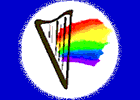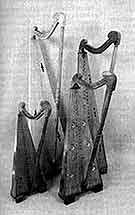














| The Spanish Double Harp:Arpa de dos òrdenes (Full text) by Hannelore DeVaere One of the first collections that refers to the use of the harp as a solo instrument in Spain is the "Musica en cifras para vihuela" of 1546 by Alonso Mudarra. Not only does this collection contain the first solo for the harp, it also has a "Fantasia que contrahaze la harpa en la manera de Ludovico", a fantasia that shows how the harp is played by a certain Ludovico. Ludovico was probably an Italian virtuoso and there was a Ludovico present in the service of Ferdinando V of Aragona. |
 |
|
The theoretical treatise of Juan Bermudo,"Declaracion de
instrumentos musicales" from 1555 describes the difficulties in playing
the harp and the great ability of Ludovico: "I was told that the named
Ludovico, whenever he played a cadence, he placed a finger under the
string and thus made it sound as a semitone. Great ability was
required to do that". His harp was clearly a diatonic one and the
semitones had to be made artificially. Around 1565, several harpists worked in the minor Spanish Court chapel in Madrid. This chapel was under the survey of the sister of Philip II, Johanna, and of the third wife of Philip II, Isabelle de Valois. We know two harpists by name: Antonio Martinez de Porres and Juan de Cortijo. There were also two harpmakers present: Juan de Carrion and Francisco de Arteaga. Antonio Martínez de Porres, the harpist, was probably a harpmaker as well, and he may have built chromatic harps around 1550, maybe even with crossed strings. According to Cristina Bordas, he was also the first harpist in the main royal chapel, appointed in1600. From that year onwards, there are also invoices by violeros, or luthiers, who made and repaired harps for the royal palace. Around 1590, Luis Zapata, a courtier, described the addition of extra strings on a harp as a new invention. He only states that the strings are 'interwoven' (entretegidas). It is not clear whether these were crossing the first row or not. Juan de Rojas Carrión, the grandson of Juan de Carrión, was a violero in Madrid who presumes in a document, dated 1602, that his grandfather, active between 1550 and 1600, was the inventor of the arpa de dos órdenes. But what does 'inventing' mean? It is quite possible that Juan de Rojas Carrión only meant that his grandfather improved the harp and made it accessible for a larger audience. Harps were usually built by violeros . These were united in guilds which had their own rules to accept newcomers. The luthiers had to built several instruments as an entrance requirement. In the second half of the sixteenth century these instruments were a "Spanish" guitar and an arpa de dos órdenes. I refer the reader to the findings of Cristina Bordas for a more detailed report on the builders in Madrid. All these scattered references to an obvious change in the organology of the Spanish harp culminate in the first clear report on a new instrument, when Antonio Hidalgo built a harp in 1616 for the harpists in the royal chapel. This harp has a second row of chromatic strings crossing the first diatonic row, and is referred to as an arpa de dos órdenes. In the second half of the seventeenth century, there is a literary reference that shows how this harp was received. The poet Lope de Vega, in his play 'La Dorotea' from 1632, lets Dorotea tune her harp: "Perdonad el afinarla [el arpa]; que es notable el gobierno de esta república de cuerdas" whereupon her visitor Bela counters "Las dos órdenes hacen mas faciles los bemoles", that with the additional rank of strings, the flats are easier to play: So even though this 'republic of strings' is more difficult to tune, it is easier to play chromatic notes on it! The Italian Bartolomeo Jobernardi [Giobernardi] was in the service of the royal chapel of Philip IV in 1633. In that period, he writes his Tratado de la musica, a treatise consisting mainly of the description of the three instruments that he had made for him. Jobernardi describes the Spanish harp as an "Arpa con las cuerdas encruciadas que llaman de dos órdenes". He compares it with the Italian triple harp that he considers 'perfect'. In his description, the Spanish harp has only a couple of chromatic notes, not a full rank, serving only to play cadences. Therefore, he states, the instrument is less perfect then the Italian harp of the time. Two books by Lucas Ruiz de Ribayaz and Diego Fernández de Huete give us a lot of information on the music written for this harp. Ribayaz' "Luz, y norte musical" from 1677, consists of a theoretical discussion on the arpa de dos órdenes and is followed by a set of solo dances for this harp. Huete's "Compendio numeroso... para harpa de una orden, de dos órdenes... in two parts" dates from 1702 and 1704. The first volume deals with a theoretical section, followed by a set of dances in tabulature (as by Ribayaz), clearly meant for the keen amateur. The second book has a theoretical and a musical part on religious music and is more directed towards the professional musician, with a stress on continuo playing. The treatise by Pablo Nassarre, "Escuela música", gives more organological information. This book was written over a period of fifty years and was only published in 1724, but we can assume that the information on the harp dates from the same period as the works of Ribayaz and Huete. The evolution of the arpa de dos órdenes did not banish the use of the arpa de un orden or diatonic [single row] harp. Both instruments were used in Spain until the early 18th century. Even though Ribayaz and Huete principally speak about the arpa de dos órdenes, they still give information on how to play the diatonic harp. As late as 1702, Huete still states that 'the sonority and the perfection of the harp with two rows of strings is diminishing the use of the one with only one row'. Nassarre writes in 1724 that "the use of the harp with two rows of string is recent". On the diatonic harp, performers such as the Ludovico at the beginning of this chapter could play chromatic notes by means of retuning, placing of nails, fingers or tuning key on the string or simply by omitting the chromatic note. Nassarre still describes some of these techniques so we can assume the arpa de una orden was played at the time. He also describes the harp as a church instrument that is used almost as much as the organ. The harp possesses two qualities that make it extremely apt for this purpose: "Among the instruments with gut strings, the harp is the one which should hold first place, on account of its enlargement [wide range] as well as its great resonance. For in both respects it exceeds all the other gut-stringed instruments which are in use at this time...It is more resonant than any other one. Thus music chapels accompany themselves with the harp, for its tones have sufficient body for this usage." The harp was mainly used as a continuo instrument, although one should not underestimate its popularity as a solo instrument for dance music. Nassarre, however, stresses the fact that the main duty of the church harpist was to accompany mass and not to perform as a soloist: "In many cathedrals they make use of the instrument of the harp by having a musician set aside solely for it. Inasmuch as his admission is usually decided by an examination, I will state here the order which should be observed in it. Harpists should be extraordinary in two areas, on which the examiners should focus all their attention. One is the execution as regards playing the instrument, and the other concerns accompaniment...All those who possess greater skill in accompaniment ought to be preferred, even if they are somewhat less skilled than others in the execution of free playing." The harp was certainly not only a church instrument. When the ambassador
of Morocco visits Spain in 1690-1691, he makes the following remark:
"One of the greatest marks of graciousness shown us by the inhabitants
of Utrera was that during the night we passed in their town, they
brought to us the monks who excelled in singing in their churches. These
had musical instruments, one among others which they call the harp; it
is garnished with a great number of
strings and resembles a weaver's loom...This harp is a large wooden
instrument as high as a man and having about 46 strings. It produces
harmonious sounds and one does not see the blow given by him who plays
it. The Christians make such use of it and teach it to their wives, sons
and daughters. Hence it is rare to find a home all of whose indwellers
do not skillfully pluck the harp. When they receive guests, when they
are welcoming anyone or when they wish to honour someone who has come to
see them, they let the harp
express what they feel. The persons who most cultivate this instrument
are the sons and daughters of the great and noble. It is similarly much
in use in their chapels, in their churches and all those places in which
they indulge themselves in their impious acts. It is the instrument they
employ most of all." It is quite obvious that the harp was very popular
around the turn of the century. Video link:
Andrew Lawrence-King plays the Spanish double harp |
|
| [To footnotes/biblography] | [To author biography] | [To abridged text] | [To top of page] |
Historical Harp | Folk and World Harp | Pedal Harp |
Harp Building | Harp Works | Non-Harps |
Camps & Concerts | Links | Glossary |
Donate! | Get Involved! | Contact Us | About Harp Spectrum
Copyright 2002 - 2017, Harp Spectrum All Rights Reserved